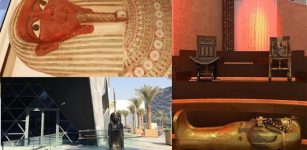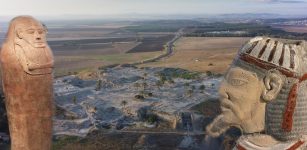Did A Universal Ancient Civilization Give Birth To All Other Cultures Across The World?
Ellen Lloyd - AncientPages.com - Despite our cultural, traditional, religious, and linguistic differences, humans are often alike. That is not surprising because we all belong to the same race.
When we study our ancient past, we find striking similarities between cultures separated by vast distances. Ancient people who were not supposed to have contacted each other constructed almost identical buildings used the same symbols, and relied on similar religious rites in their daily lives. There is no doubt prehistoric civilizations shared universal scientific and technological knowledge.
Are ruins of a universal ancient civilization submerged? Credit: Adobe Stock - Sven Bachstroem
Are these striking ancient similarities we encounter worldwide a result of a universal mind or rather a legacy of a universal ancient civilization that gave birth to all other ancient cultures worldwide? Was there once a global mother civilization that predated all ancestral civilizations?
Today, Mesopotamia is recognized as the cradle of civilization, but in recent years, some scholars have challenged this theory.
"More and more evidence confirms a very brave thesis, according to which the Balkan Peninsula, rather than ancient Mesopotamia that is the cradle of our civilization.
The evidence of a little-known culture preceding Egyptian and even Sumerian culture has been attracting the attention of researchers, turning everything we know about antiquity upside down.
Remains of this ancient society have gradually been emerging from the ashes of human history, taking us some 6-7 millennia back when a highly-advanced unknown civilization flourished in our lands. This period preceded Sumer and Akkad by at least one millennium." 1
It is true that around 8,000 years ago, people in Mesopotamia practiced agriculture and ancient Sumerians led the foundation of what is today defined as a civilization. We cannot dispute the fact that Mesopotamia changed the world. Still, we also cannot ignore that there are ancient underwater ruins that predate the Sumerian civilization. These structures testify to the existence of even older cultures on our planet.
As an example, we can mention Dwarka has long been considered a mythic place. However, the discovery of underwater ruin in the Gulf of Cambay has confirmed Dwarka did exist, and the vast city "is believed to predate the oldest known remains in the subcontinent by more than 5,000 years. Mainstream scientists maintain that ancient Indian culture/civilization goes back some 4-5 thousand years. Yet the ruins below the Gulf of Cambay go back at least 9 thousand years, i.e. to the time when the area submerged underwater.
This means that the city must have existed before the flooding, i.e., at least 9 thousand years ago." 2
We must also consider the fact that most of our oceans remain unexplored. This means we cannot dismiss the possibility that even older than 9,000 years can lie hidden in the waters awaiting our discovery.
Can remains of a universal prehistoric civilization be submerged? It is certainly possible. There are so many similarities between ancient civilizations that it is impossible to discuss them in this article, but we can mention a few examples.
"Most people think of Egypt when the word "pyramid" is mentioned. Although the Egyptian pyramids are today most well-known and keep attracting tourists, we must not forget that pyramids were built worldwide in ancient times. Research on connections between ancient people reveals that pyramids and dolmens were standard in different parts of the world.
Credit: MessageToEagle.com
Ancient dolmens are yet another great example of ancient universal thinking. The ancient traditions were the same despite the vast distance separating these cultures. Let us also keep in mind that the builders of the dolmens were unrelated to each other. Intriguing, isn't it?" 3
We find hand paintings depicted in rock art around the world and for some unknown reason, our ancestors carved the spiral symbol on countless rocks, sculptures, boulders, and ancient cave walls worldwide.
Credit: MessageToEagle.com
There are, of course, different opinions "as to how far these civilizations can be regarded as isolated and separate, but no doubt history reveals large-scale social unities with easily recognized cultural characteristics. Further, these unities exhibit periods of growth, maturity, and decline: this phenomenon seems universal, for it is found in the civilizations of Central America and in those of the old world. It is indeed an amazing panorama that history reveals; there can be no doubt about the general nature of the course of events, however, obscure the details may be. Civilizations go uphill and downhill with a certain inevitability." 4
Our ancestors on different continents had more in common than we previously thought.
Therefore, it is valid to ask whether this universal knowledge was a legacy of a long-gone mother culture whose people survived a catastrophe and created new civilizations worldwide.
Written by Ellen Lloyd - AncientPages.com
Updated on September 3, 2022
Copyright © AncientPages.com All rights reserved. This material may not be published, broadcast, rewritten or redistributed in whole or part without the express written permission of AncientPages.com
Expand for references- Ellen Lloyd - Thought-Provoking Theory Suggests Balkan Peninsula And Not Mesopotamia Was The Cradle Of Civilization, AncientPages.com
- A. Sutherland - Dwarka – Pre-Harappan City That Could Rewrite The History Of The World, AncientPages.com
- Ellen Lloyd - 10 Remarkable Similarities Between Ancient Civilizations, MessageToEagle.com
- Carr-Saunders, Alexander. "What Is A Civilization?" Theoria: A Journal of Social and Political Theory, no. 6 (1954): 9-15.
More From Ancient Pages
-
 Ancient Coffin Of Priest Psamtik, Son Of Osiris And Five Replicas Of Goddess Maat Sent On Upcoming Expo
Archaeology | Oct 5, 2021
Ancient Coffin Of Priest Psamtik, Son Of Osiris And Five Replicas Of Goddess Maat Sent On Upcoming Expo
Archaeology | Oct 5, 2021 -
 Three Grave Steles Unearthed At Istanbul’s 1,500-Year-Old St. Polyeuktos Church
Archaeology | Aug 24, 2023
Three Grave Steles Unearthed At Istanbul’s 1,500-Year-Old St. Polyeuktos Church
Archaeology | Aug 24, 2023 -
 Mysterious Toaleans – Remains Of Unknown Humans Who Lived 8,000 Years Ago Discovered In The Leang Panninge Cave
Archaeology | Aug 26, 2021
Mysterious Toaleans – Remains Of Unknown Humans Who Lived 8,000 Years Ago Discovered In The Leang Panninge Cave
Archaeology | Aug 26, 2021 -
 1,200-Year-Old Rock-Cut Temple Found On Banks Of Arjuna River,Tamil Nadu, India
Archaeology | Sep 3, 2020
1,200-Year-Old Rock-Cut Temple Found On Banks Of Arjuna River,Tamil Nadu, India
Archaeology | Sep 3, 2020 -
 Is Mysterious Herlaugshaugen The Ship Burial Of Viking King Herlaug?
Archaeology | Jul 11, 2023
Is Mysterious Herlaugshaugen The Ship Burial Of Viking King Herlaug?
Archaeology | Jul 11, 2023 -
 2,000-Year-Old Stringed Instrument Found In Vietnam
Archaeology | Feb 22, 2023
2,000-Year-Old Stringed Instrument Found In Vietnam
Archaeology | Feb 22, 2023 -
 Queen Teuta: Power-Hungry Villain Who Underestimated The Romans
Featured Stories | Oct 31, 2019
Queen Teuta: Power-Hungry Villain Who Underestimated The Romans
Featured Stories | Oct 31, 2019 -
 Goibniu: The Sword Smith Of Tuatha De Danann Who Forged Weapons For Battles In Celtic Mythology
Celtic Mythology | Jan 31, 2020
Goibniu: The Sword Smith Of Tuatha De Danann Who Forged Weapons For Battles In Celtic Mythology
Celtic Mythology | Jan 31, 2020 -
 Evidence Of Rare Roman-Celtic Temple Near Lancaster Castle
Archaeology | Mar 9, 2023
Evidence Of Rare Roman-Celtic Temple Near Lancaster Castle
Archaeology | Mar 9, 2023 -
 Ancient Mystery Of The Biblical Canaanites – New DNA Insight
Archaeology | May 28, 2020
Ancient Mystery Of The Biblical Canaanites – New DNA Insight
Archaeology | May 28, 2020 -
 On This Day In History: Du Fu – ‘The Sage of Poetry’ Was Born – On Feb 12, 712
News | Feb 12, 2017
On This Day In History: Du Fu – ‘The Sage of Poetry’ Was Born – On Feb 12, 712
News | Feb 12, 2017 -
 Neanderthal Genes Influence Your Mood And Much More – Study Shows
Archaeology | Oct 6, 2017
Neanderthal Genes Influence Your Mood And Much More – Study Shows
Archaeology | Oct 6, 2017 -
 Ancient Mystery Of The Unknown White Bearded Rulers
Civilizations | Apr 21, 2020
Ancient Mystery Of The Unknown White Bearded Rulers
Civilizations | Apr 21, 2020 -
 Smallest Arm Bone In Human Fossil Record Illuminates Homo Floresiensis Origin
Archaeology | Aug 7, 2024
Smallest Arm Bone In Human Fossil Record Illuminates Homo Floresiensis Origin
Archaeology | Aug 7, 2024 -
 Riddle Of The Ancient Lost City Beneath Missouri – A Puzzling Discovery
Civilizations | Mar 21, 2022
Riddle Of The Ancient Lost City Beneath Missouri – A Puzzling Discovery
Civilizations | Mar 21, 2022 -
 Mythical Kingdom Of Prester John – Did It Exist?
Featured Stories | Mar 21, 2016
Mythical Kingdom Of Prester John – Did It Exist?
Featured Stories | Mar 21, 2016 -
 Surprising Discovery Of Almost Intact Roman Sanctuary With Temples In The Netherlands
Archaeology | Dec 23, 2022
Surprising Discovery Of Almost Intact Roman Sanctuary With Temples In The Netherlands
Archaeology | Dec 23, 2022 -
 First Insight Into 3,500-Year-Old Cuisine Of The Enigmatic Nok Culture
Archaeology | Jan 17, 2022
First Insight Into 3,500-Year-Old Cuisine Of The Enigmatic Nok Culture
Archaeology | Jan 17, 2022 -
 Was King William II Murdered In The New Forest?
Featured Stories | Aug 5, 2021
Was King William II Murdered In The New Forest?
Featured Stories | Aug 5, 2021 -
 Ancient Tomb Chamber Of Parthian Warrior Was Accidentally Unearthed In Iran
Archaeology | Apr 30, 2020
Ancient Tomb Chamber Of Parthian Warrior Was Accidentally Unearthed In Iran
Archaeology | Apr 30, 2020




